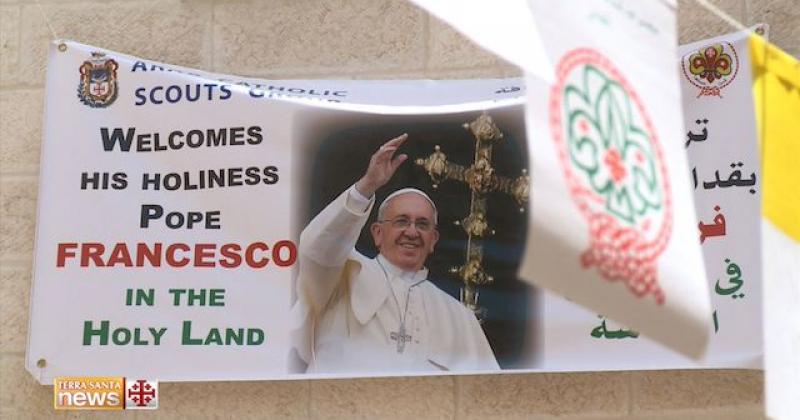The excitement over the visit of Pope Francis to Jerusalem is gradually building as the hours pass and the moment of his arrival approaches. One sees it in subtle signs: an intensification of security checks, heightened police attention in particularly sensitive areas (such as Temple Mount - or al-Aqsa Mosque esplanade - and the area around the Cenacle, also known as the “Upper Room,” where tradition has it that the Last Supper was celebrated). The fear, especially following a series of vandalistic attacks in the last weeks against Christian buildings, is that groups of trouble-making ultra-orthodox Jews might think of staging some protest in order to harm the image of the Pope on such an important occasion. For this reason, Israeli security sources explain that they have gone on maximum alert. At least eight thousand agents will cover the Holy City, in order to avoid any risk that might come from inside the Jewish community this time as well as from other fundamentalist groups.
Stirring the waters these last few weeks, insistent rumors have been circulating pertaining to an alleged agreement between the Israeli government and the Holy See regarding the Cenacle. A few days ago, on May 11, even the authoritative daily The Jerusalem Post, which traditionally takes a pro-government stance, intervened on the question: “A certain number of Jewish spiritual leaders, including Rabbi Simcha Hacohen Kook [the venerable Chief Rabbi of Rehovot] together with right-wing politicians, have affirmed, without any proof, that the State of Israel is set to sign an accord with the Holy See ceding it control over the entire building. These assertions seem concocted to stir up animosity toward Christians, drawing on the deep well of Jewish distrust stemming from centuries of Christian persecution of the Jews. Representatives of the Ministry of Foreign Affairs and the Chief Rabbinate have struggled in vain to calm the public by declaring that the State has no intention of renouncing control of the area, and that the sole object of the negotiations is the question of usage rights pertaining to the Room of the Last Supper. And that in any case, an accord is still not in view.”
Given that “fundamentalist Jews of various extraction (such as the ultra-orthodox and religious Zionists) have increased their presence and their demonstrations near Mount Zion,” the fears of disorder and protests are by no means unfounded. In fact, the security apparatus is leaving nothing to chance in order to ensure that the Papal visit might occur without any unfortunate incident. This includes limiting (or at least impeding) the access to the Old City up to the night of Saturday, May 24.
If Jerusalem seems to be waiting for the Pope without any emotional involvement (except for the large banners in the Christian neighborhoods, the city government has decorated the streets along which the Pope will pass in a decidedly sober manner), a completely different mood is felt in Bethlehem, where preparations are underway for the solemn mass on Manger Square scheduled for the morning of Sunday, May 25. The Holy Father, after meeting with Palestinian political authorities and celebrating the mass, where at least 10,000 people are expected, will have lunch in the complex of the “Casa Nova” Palace, the Franciscan pilgrimage house on the side of the Basilica of the Nativity, with a number of Palestinian families in difficulty due to the Israeli-Palestinian conflict. This group includes pacifist protestors against the route of the Green Line, an Israeli wall of separation, on the Cremisan hill which risks cutting off fields and families from Bethlehem. In the afternoon, Pope Francis will visit the Phoenix Center, a social center serving primarily the Palestinians from Dheisheh, one of the refugee camps set up after 1948 following the birth of the State of Israel. The Phoenix Center is overseen by Mohammed Iahham, a deputy of the Fatah party in the Palestinian parliament, who welcomes us in an office filled with photos portraying him together with various Popes. “I was a child when I saw Pope Paul VI arrive here in the Holy Land. Then I welcomed Popes John XIII and Benedict XVI together with other Palestinian leaders. The fact that Pope Francis is coming here, among our people, is already of enormous importance. A choice that by itself says more than many position statements.”
In the hall that will welcome “Papa Bergoglio,” a series of blowups have been hung on the walls that recount the story of the expulsion of 750,000 Palestinians from their homes and their lands. Eloquent images, which immediately give a sense of context to the scheduled meeting. Iahham stresses that “There will be no politicians. The protagonists will be around a hundred schoolchildren. They will meet the Pope and will sing for him a song in Arabic and one in Italian. Then, some of them written out wishes to read to the Pope and leave with him: thoughts that they have composed together with their teachers. We will keep these texts secret until the last moment, because we sincerely desire that the Pope will be able to listen to the words of our children with wonder.”
Iahham takes his leave of us while a group of workers are hanging a gigantic welcome poster for Pope Francis. A number of drawings are hung on a notice-board in the office: children playing with a ball in a field without fences, cannon-less tanks pulling a plow, sailboats on a blue sea, a circle of hands of various colors. . .
These images invoke the dreams of freedom of the children of Dheisheh, just south of Bethlehem, in the West Bank.
